Spring Vegetable Risotto
Spring Vegetable Risotto is creamy vegetarian risotto packed with spring produce and bursting with fresh lemon flavor. Recipe includes tips to make perfect risotto every single time!
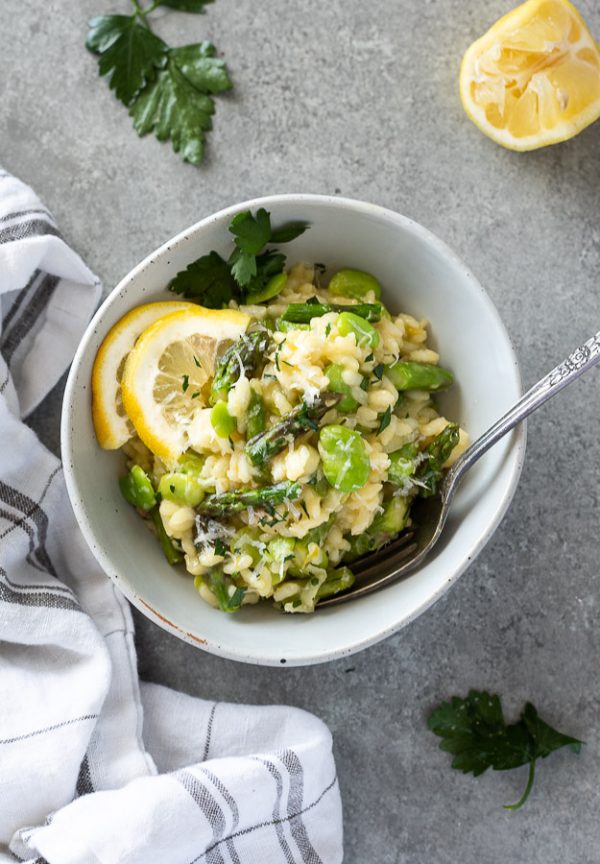
June has officially arrived, which means there are only a few short weeks of spring left. I intend to make the most of the last few weeks by making plenty of pasta primavera, asparagus soup and this Spring Vegetable Risotto before all the spring produce is gone!
Risotto is one of my favorite dishes, and I love how versatile it is. It’s a wonderful way to showcase the produce in any season, such as butternut squash, pumpkin, mushrooms and so much more!
This dish can be intimidating, but I promise if you follow the tips I’ve outlined below, your risotto will be perfect every time. 🙂
Why you’ll love this recipe:
- It’s nice and creamy, with plenty of texture from perfectly al dente arborio rice and an abundance of spring vegetables.
- This recipe is packed with flavor from garlic, leeks, fresh lemon juice and zest, and parmesan cheese.
- It’s an easy meatless meal that’s made in one pot.
- This spring risotto is customizable using your favorite fresh or frozen vegetables, and may be served as a main dish or side dish.
Recipe ingredients
There are only a few ingredients in this recipe, which can be easily customized with your favorite ingredients or utilizing what you have on hand.
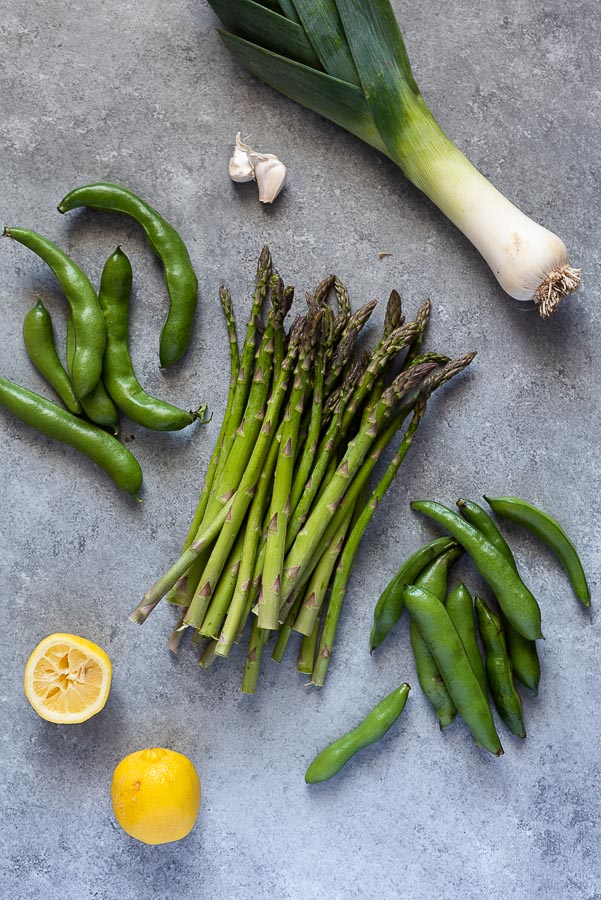
- Arborio rice. For best results, use arborio rice, which is an Italian short-grain rice. The grains are higher in starch, firm and creamy, which makes it the best for risotto.
- Asparagus. Use fresh asparagus. No asparagus? Mushrooms are a great addition.
- Fava beans. I always cook the fava beans in advance and store them in the refrigerator to add to my recipes. Fresh or frozen peas may be substituted.
- Leeks. May be substituted with white onion or shallots.
- Garlic. A bit of fresh garlic adds big flavor.
- Lemon zest and juice. Fresh lemon juice and zest brightens all the flavors.
- Vegetable stock. I used a combination of 4 cups of Homemade Vegetable Stock and 2 cups of water. I opted not to include white wine in this vegetable risotto recipe because the lemon juice and zest provide the acidity that the wine typically adds. If you’d like to add it, I’ve included instructions in the recipe notes.
- Butter. A bit of butter lends an even creamier mouthfeel. You can omit it to make this risotto dairy-free.
- Parmesan cheese. This adds umami flavor, but it may be omitted along with the butter to make this risotto dairy-free.
What is risotto?
Risotto is a traditional Italian dish made from short-grain white rice. The most commonly used rice is arborio rice, which has a higher starch content than traditional rice. The higher starch content results in a creamier rice.
Perfect risotto is creamy yet al dente, which is achieved by using the risotto method, or stirring in hot stock in small amounts during the cooking time.
Risotto is rather high maintenance as it requires frequent stirring. If you’d like to take a hands off approach, try my Instant Pot mushroom risotto and pumpkin risotto!
No Instant Pot? Be sure and try my butternut squash risotto, which is baked in the oven.
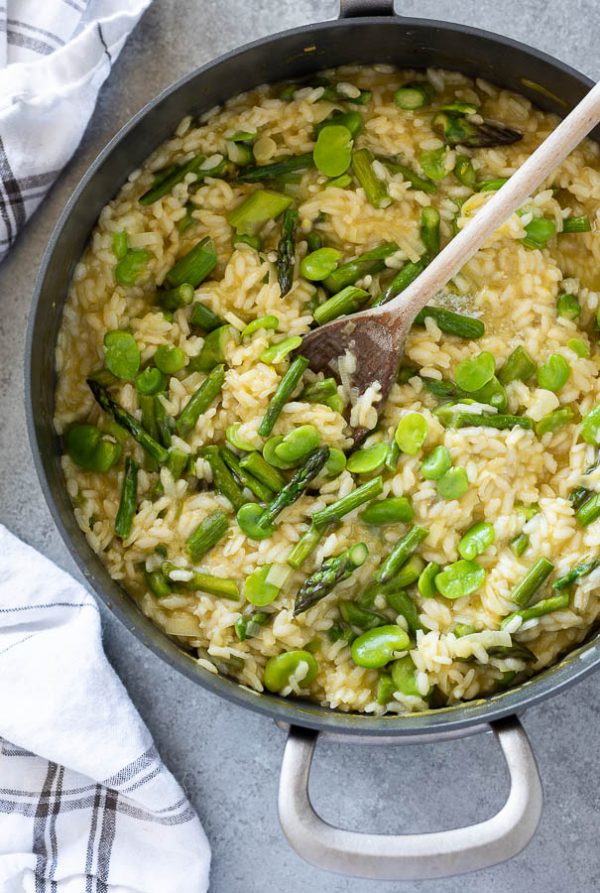
Recipe tips
Risotto has a bad rap for being difficult to make, but it’s really quite easy. I’ve outlined a few simple things to remember when making risotto, and you’ll get perfect results every single time.
- Give the risotto your undivided attention. It’s best not to multitask when cooking risotto as you’ll need two hands — one to add hot stock one ladleful at a time and one to stir.
- Use a large, heavy bottomed pan. A pan with a large amount of surface area will result in risotto that’s cooked more evenly.
- Always use warm stock when cooking risotto. Adding cold stock to a hot pot reduces the temperature of the contents and disrupts the cooking process. I used cold stock the first time I ever made risotto with disastrous results, and I’ll never make that mistake again.
- Use 4 cups of stock/liquid per every cup of rice. I recommend using stock for flavor. I used 4 cups of stock and 2 cups of water in this recipe.
- Add stock slowly, one ladle full at a time. Adding the stock slowly allows the rice to absorb the liquid rather than boiling in the liquid.
- Stir often. But not too often. There’s no need to stir risotto continuously — doing so can cool the rice down and may result in gluey rice. Simply stir a couple of times a minute to keep things moving for perfectly creamy risotto and to prevent burning.
- Risotto is best served immediately. This is not a make ahead dish as the risotto becomes gluey or sticky as it sits.
How to make this recipe
This vegetable risotto is very easy to make following the steps below.
Pro tip: Prep your vegetables in advance to make this recipe go even more quickly!
See the recipe card below for full instructions.
Gather your ingredients.
Prep your veggies and have everything measured out and at the ready.
Heat the stock.
Bring the stock to a boil in a sauce pan, then reduce the heat to medium low and simmer. Place a ladle nearby.
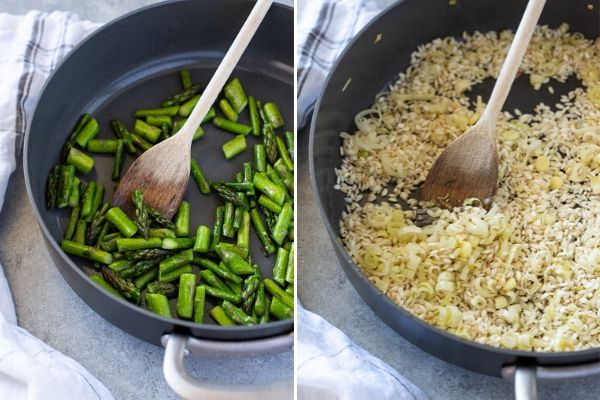
Cook the asparagus.
Cook the asparagus for 2-3 minutes or until crisp tender, then transfer the asparagus to a bowl and set aside.
Cook the leeks and garlic, and toast the arborio rice.
Sauté the leeks 3-4 minutes or until softened. Add the garlic and cook 30 seconds longer.
Add the arborio rice to the skillet and stir to coat with the oil. Cook the rice 1-2 minutes longer, stirring constantly until fragrant.
If adding wine, add it at this point and stir the risotto until the wine has been absorbed by the rice.
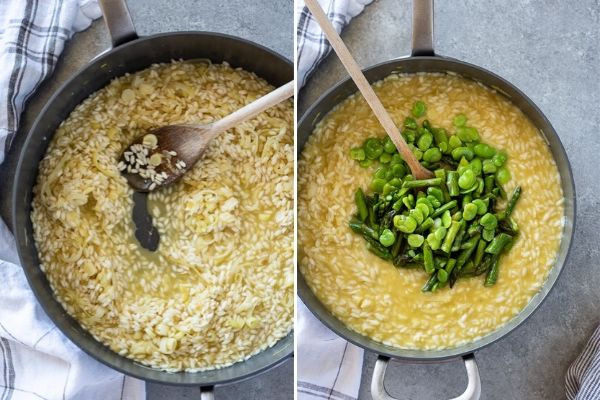
Slowly add the stock, stirring frequently.
Add one ladleful of stock (about 1/2 cup), stirring frequently until the liquid has been absorbed.
The risotto is ready for more stock when you can draw a line through the rice with a wooden spoon and the liquid stays put.
Continue adding the hot stock until it’s all been added. The risotto is done when it’s nice and creamy yet still firm to the bite.
Add the vegetables to the risotto
The vegetables should be added during the last minute of cooking.
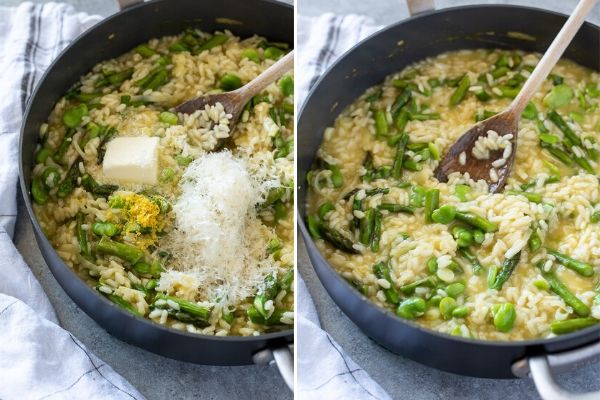
Finish the risotto.
Finish up the risotto by removing it from heat and stirring in the lemon zest, juice, butter and parmesan cheese. Taste, then adjust the seasoning as necessary
Serve immediately with additional parmesan cheese and lemon, if desired.
Recipe notes
- Pro tip: Prep your vegetables in advance to make this recipe go even more quickly!
- Fava beans may be cooked in advance following my recipe How To Cook Fava Beans. The fava beans may be substituted with fresh or frozen peas.
- If you would like to go the classic route and white wine to your risotto, add 1/2 cup dry immediately after toasting the arborio rice and reduce it down to about 2 tablespoons.
- Omit the butter and parmesan cheese to make this a vegan risotto.
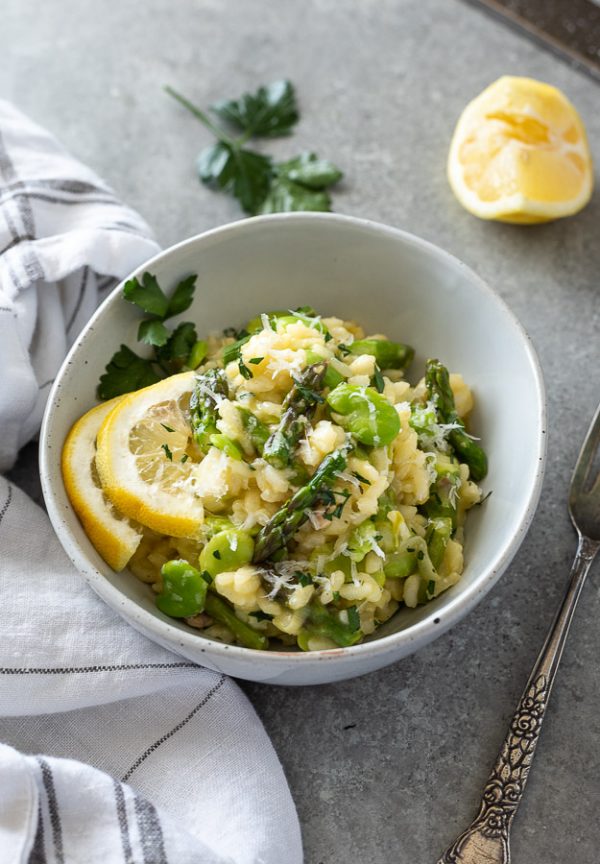
More risotto recipes you’ll love:
- Saffron risotto by Epicurious
- Short rib risotto
Did you try this recipe? If so, be sure to leave a review below and tag me @flavorthemoments on Facebook and Instagram

Spring Vegetable Risotto
Ingredients
- 4 cups low sodium vegetable stock
- 2 cups water*
- 3 tablespoons olive oil divided
- 1 bunch asparagus trimmed and sliced on the bias into 1″ pieces
- 1 large leek light green and white parts, halved and sliced thinly into half moons
- 2 cloves garlic minced
- 1 1/2 cups arborio rice
- 1 cup cooked fava beans*
- 1 lemon zested and juiced
- 1/4 cup freshly grated parmesan
- 1 tablespoons softened unsalted butter
Instructions
- Place the stock and water in a sauce pan and bring to a boil over medium heat. Reduce heat to low and continue to simmer.
- Heat 1 tablespoon olive oil in a large sauté pan over medium heat. Add the asparagus and cook until crisp tender, 3-4 minutes. Remove from pan and set aside.
- Add the remaining 2 tablespoons of olive oil. Add the leek and cook until softened, about 2 minutes. Add the garlic and cook for 30 seconds longer. Add the arborio rice and toast in the pan, stirring constantly until toasted, 1-2 minutes..
- Slowly add one ladleful (about 1/2 cup) of the warm stock, stirring the risotto frequently. Add an additional ladle full of stock each time the liquid has been absorbed, until all of the stock has been added and the risotto is al dente. The rice is ready for more stock when you can draw a line through the risotto with a wooden spoon and the liquid stays put.
- Add the asparagus and fava beans to the risotto during the last minute of cooking.
- Remove the risotto from heat and add the lemon zest, juice, parmesan cheese and butter, and season with salt and pepper to taste. Serve immediately and enjoy!
Notes
- Pro tip: Prep your vegetables in advance to make this recipe go even more quickly!
- Fava beans may be cooked in advance following my recipe How To Cook Fava Beans. The fava beans may be substituted with fresh or frozen peas.
- If you would like to go the classic route and white wine to your risotto, add 1/2 cup dry immediately after toasting the arborio rice and reduce it down to about 2 tablespoons.
- Omit the butter and parmesan cheese to make this a vegan risotto.
Nutrition
Nutrition is estimated using a food database and is only intended to be used as a guideline for informational purposes.
**This recipe was originally published in April 2016. I’ve added step by step photos, instructions and recipe tips, and updated the photos.

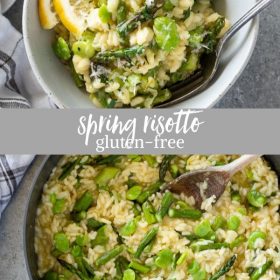

57 Comments on “Spring Vegetable Risotto”
There used to be a time when I would always order a risotto whenever we went out to eat. I mean, what is there not to love? It’s delicious, cozy, home-cooking kind of meal, there’s so many different varities and flavours, and it’s not messy to eat socially (very important, of course). I am much more adventurous these days but I still feel lots of love for risotto – and this looks absolutely scrumptious – those are my favourite spring greens so I can definitely see myself making this a lot! Another lovely recipe, Marcie!
I don’t order risotto out as much as I used to, but I make it at home more often as my boys really like it! Thank you Katerina!
Marcie, this is so perfect for spring!! What a delicious dish! We love risotto, I don’t know why I don’t make it more often. The asparagus is perfect in it!
Thanks Katherine! I must admit I prefer to make risotto in the Instant Pot because of the stirring…it is so much easier!
Love risotto and this spring version looks delicious Marcie! I just picked up some fresh asparagus the other day and this would be the perfect use for it!
Sounds like great timing! Thanks Leanne!
Risotto is one of my favourites, and this looks incredible, Marcie!! Love those fresh flavours – the perfect Spring time dish!
Thank you so much Alex!
Oooh I love risotto! I’m also a fan of using fresh lemon zest in pasta/rice dishes. It gives it such a fresh flavor right? I’ll definitely have to try this recipe sometime this spring! I think my hubby would love it.
What a delicious spring dish! Asparagus is one of my favorites too!
Thank you, Laura!
I can’t get enough asparagus this time of year either. Love that you used fava beans for this risotto as well. They are one ingredient I need to use more in my cooking. 🙂
Thank you, Christin!
This looks so delicious and perfect for spring!! I’ve been eating a lot of asparagus, too – so I guess we can turn green together 😉
Glad to hear I’ll have another green friend! haha Thanks, Megan! 🙂
I am hungry looking at this one. Amazingly delicious.Love the recipe!
Thank you so much, Kushi!
So I’m kind of embarrassed that I’ve never tried fava beans before! And now I’m wondering why because this risotto looks fantastic, Marcie!
Don’t be embarrassed! Fava beans are huge and crazy looking and I never knew what they were until we made them in cooking school. haha Thanks, and have a great rest of the week! 🙂
I just had asparagus last night for dinner so don’t worry I’ll be turning green with you. 😉
This risotto sounds heavenly! I’ve never tried cooking with fava beans but I need to. I’ll definitely be using your guide as a resource when I do! 🙂
Glad to hear we can be green together! 🙂 Thank you, Sarah, and hope you’re having a great week!
I so wish I had a bowl of this right now!
Thanks, Jocelyn…I’ll send one over! 🙂
I can’t get enough asparagus lately! This risotto is gorgeous and would disappear in a hurry at our house!
Sounds like you’re with me on the asparagus obsession! haha Thanks so much, Jessica! 🙂
This is a genius recipe, Marcie! Yay for this spring-y vegetable lemon risotto. LOVE that you packed with full of veggies! Totally craving a big bowl of this right about now! So healthy and seriously delicious!
Thank you, Anu! This was such a nice way to enjoy spring veggies!
I adore anything risotto. I’ll be making this combo. (I’m lazy about fava beans so even if they’re not seasonal I just sub in edamame. ;-))
Thank you, Letty! I totally understand about the fava beans….they require so much effort! Edamame or peas are both perfect subs. 🙂